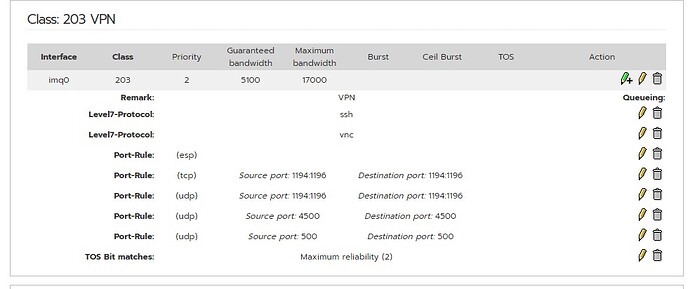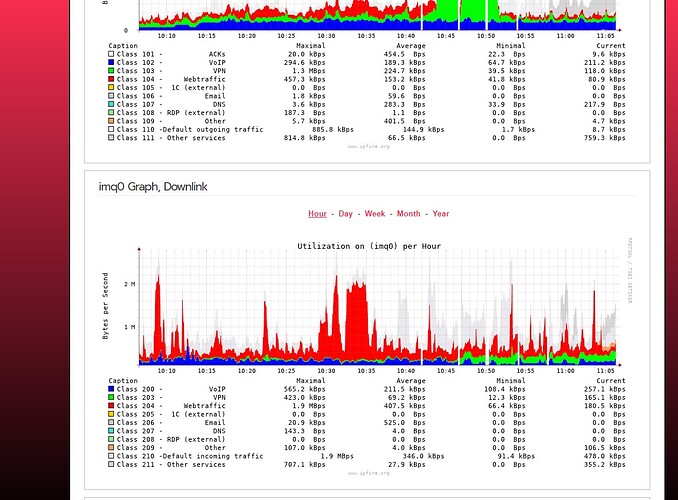Nick, I’ve followed your recommendations. Thanks to this, it was possible to divide into 2 separate classes: external traffic (srv-RW) and external traffic (srv-srv) - only the MX server communicates there. Thank you.
However, the main question remains - how to work with traffic that travels through other interfaces? tun0 and tun1, which I mentioned earlier
It is not present on the red0 and imq0 interfaces, which is logical because this is internal traffic.
[root@gw ~]# tcpdump -i red0 -c 10 host 192.168.7.182
tcpdump: verbose output suppressed, use -v[v]… for full protocol decode
listening on red0, link-type EN10MB (Ethernet), snapshot length 262144 bytes
^C
0 packets captured
13 packets received by filter
0 packets dropped by kernel
[root@gw ~]# tcpdump -i imq0 -c 10 host 192.168.7.182
tcpdump: verbose output suppressed, use -v[v]… for full protocol decode
listening on imq0, link-type EN10MB (Ethernet), snapshot length 262144 bytes
^C
0 packets captured
21 packets received by filter
0 packets dropped by kernel
[root@gw ~]# tcpdump -i tun1 -c 10 host 192.168.7.182
tcpdump: verbose output suppressed, use -v[v]… for full protocol decode
listening on tun1, link-type RAW (Raw IP), snapshot length 262144 bytes
17:23:54.927871 IP 192.168.7.182.56305 > 192.168.8.18.ms-wbt-server: UDP, length 12
17:23:54.966679 IP 192.168.8.18.ms-wbt-server > 192.168.7.182.56305: UDP, length 76
17:23:55.053044 IP 192.168.7.182.56305 > 192.168.8.18.ms-wbt-server: UDP, length 12
17:23:55.060687 IP 192.168.8.18.ms-wbt-server > 192.168.7.182.56305: UDP, length 74
17:23:55.115709 IP 192.168.7.182.56305 > 192.168.8.18.ms-wbt-server: UDP, length 12
17:23:55.185521 IP 192.168.8.18.ms-wbt-server > 192.168.7.182.56305: UDP, length 75
17:23:55.242169 IP 192.168.8.6.http > 192.168.7.182.60677: Flags [S.], seq 2062167230, ack 3117272492, win 64240, options [mss 1155,nop,nop,sackOK,nop,wscale 7], length 0
17:23:55.242296 IP 192.168.8.6.http > 192.168.7.182.60675: Flags [S.], seq 3313654494, ack 1872910964, win 64240, options [mss 1155,nop,nop,sackOK,nop,wscale 7], length 0
17:23:55.243736 IP 192.168.7.182.60677 > 192.168.8.6.http: Flags [.], ack 1, win 514, options [nop,nop,sack 1 {0:1}], length 0
17:23:55.246067 IP 192.168.7.182.56305 > 192.168.8.18.ms-wbt-server: UDP, length 12
10 packets captured
21 packets received by filter
0 packets dropped by kernel
I tried to solve this by limiting the speed of the interfaces. The allocation for red0 is 48%, for tun0 and tun1 is 24%. However, it didn’t work
The traffic for QoS only became “unknown” and went to the default class, where the limit was reached and I observed packet dropping for a rdp connection from inside the network.
This is also true for the VPN RoadWarrior network - there was a drop of VPN packets with messages like:
RoadWarrior/x.x.x.x:2691 Package Authentication/Decryption error: Invalid package ID (possibly a repeat): [ #46660 ] – see the entry on the manual page for more information about … no-analyze and analyze --windows or disable this warning with --mute-repeat-warnings.
I’m sorting this out in another topic: Configure a class for RDP session connection - #8 by siptix
And I still don’t see a way out of this situation.


